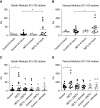Neutrophil Extracellular Traps Increase Airway Mucus Viscoelasticity and Slow Mucus Particle Transit
- PMID: 33095650
- PMCID: PMC7780998
- DOI: 10.1165/rcmb.2020-0168OC
Neutrophil Extracellular Traps Increase Airway Mucus Viscoelasticity and Slow Mucus Particle Transit
Abstract
Mucus obstruction is a key feature of many inflammatory airway diseases. Neutrophil extracellular traps (NETs) are released upon neutrophil stimulation and consist of extracellular chromatin networks studded with cytotoxic proteins. When released in the airways, these NETs can become part of the airway mucus. We hypothesized that the extracellular DNA and/or oxidative stress (e.g., by the release of reactive oxygen species and myeloperoxidase during NETs formation in the airways) would increase mucus viscoelasticity. We collected human airway mucus from endotracheal tubes of healthy patients admitted for elective surgery and coincubated these samples with NETs from phorbol 12-myristate 13-acetate-stimulated neutrophils. Unstimulated neutrophils served as controls, and blocking experiments were performed with dornase alfa for extracellular DNA and the free radical scavenger dimethylthiourea for oxidation. Compared with controls, the coincubation of mucus with NETs resulted in 1) significantly increased mucus viscoelasticity (macrorheology) and 2) significantly decreased mesh pore size of the mucus and decreased movement of muco-inert nanoparticles through the mucus (microrheology), but 3) NETs did not cause visible changes in the microstructure of the mucus by scanning EM. Incubation with either dornase alfa or dimethylthiourea attenuated the observed changes in macrorheology and microrheology. This suggests that the release of NETs may contribute to airway mucus obstruction by increasing mucus viscoelasticity and that this effect is not solely due to the release of DNA but may in part be due to oxidative stress.
Keywords: macrorheology; microrheology; muco-inert nanoparticles; multiple particle tracking; respiratory tract diseases.
Figures







Similar articles
-
Neutrophil extracellular traps cause airway obstruction during respiratory syncytial virus disease.J Pathol. 2016 Feb;238(3):401-11. doi: 10.1002/path.4660. Epub 2015 Dec 21. J Pathol. 2016. PMID: 26468056
-
Progression of Cystic Fibrosis Lung Disease from Childhood to Adulthood: Neutrophils, Neutrophil Extracellular Trap (NET) Formation, and NET Degradation.Genes (Basel). 2019 Feb 26;10(3):183. doi: 10.3390/genes10030183. Genes (Basel). 2019. PMID: 30813645 Free PMC article. Review.
-
Neutrophil extracellular traps formation by bacteria causing endometritis in the mare.J Reprod Immunol. 2014 Dec;106:41-9. doi: 10.1016/j.jri.2014.08.003. Epub 2014 Aug 27. J Reprod Immunol. 2014. PMID: 25218891
-
MiR-1696/GPx3 axis is involved in oxidative stress mediated neutrophil extracellular traps inhibition in chicken neutrophils.J Cell Physiol. 2021 May;236(5):3688-3699. doi: 10.1002/jcp.30105. Epub 2020 Oct 12. J Cell Physiol. 2021. PMID: 33044016
-
Neutrophil Extracellular Traps in Respiratory Disease: guided anti-microbial traps or toxic webs?Paediatr Respir Rev. 2017 Jan;21:54-61. doi: 10.1016/j.prrv.2016.03.007. Epub 2016 Jun 29. Paediatr Respir Rev. 2017. PMID: 27424227 Review.
Cited by
-
Airway mucus in pulmonary diseases: Muco-adhesive and muco-penetrating particles to overcome the airway mucus barriers.Int J Pharm. 2023 Mar 5;634:122661. doi: 10.1016/j.ijpharm.2023.122661. Epub 2023 Feb 1. Int J Pharm. 2023. PMID: 36736964 Free PMC article. Review.
-
Neutrophil Extracellular Traps Are Found in Bronchoalveolar Lavage Fluids of Horses With Severe Asthma and Correlate With Asthma Severity.Front Immunol. 2022 Jul 13;13:921077. doi: 10.3389/fimmu.2022.921077. eCollection 2022. Front Immunol. 2022. PMID: 35911691 Free PMC article.
-
High-throughput Mucus Microrheology for Phenotyping and Disease Modeling.bioRxiv [Preprint]. 2025 Jan 27:2025.01.09.632077. doi: 10.1101/2025.01.09.632077. bioRxiv. 2025. PMID: 39868248 Free PMC article. Preprint.
-
Role of neutrophils in acute viral infection.Immun Inflamm Dis. 2021 Dec;9(4):1186-1196. doi: 10.1002/iid3.500. Epub 2021 Sep 2. Immun Inflamm Dis. 2021. PMID: 34472718 Free PMC article. Review.
-
Engineering in vitro models of cystic fibrosis lung disease using neutrophil extracellular trap inspired biomaterials.bioRxiv [Preprint]. 2023 Jun 28:2023.06.26.546583. doi: 10.1101/2023.06.26.546583. bioRxiv. 2023. Update in: J Mater Chem B. 2023 Oct 11;11(39):9419-9430. doi: 10.1039/d3tb01489d. PMID: 37425779 Free PMC article. Updated. Preprint.
References
-
- Ma JT, Tang C, Kang L, Voynow JA, Rubin BK. Cystic fibrosis sputum rheology correlates with both acute and longitudinal changes in lung function. Chest. 2018;154:370–377. - PubMed
-
- Voynow JA, Rubin BK. Mucins, mucus, and sputum. Chest. 2009;135:505–512. - PubMed
-
- Cone RA. Barrier properties of mucus. Adv Drug Deliv Rev. 2009;61:75–85. - PubMed
Publication types
MeSH terms
Substances
Grants and funding
LinkOut - more resources
Full Text Sources
Other Literature Sources
Research Materials

